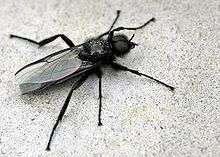Bibio marci
Bibio marci or St. Mark's fly or Hawthorn Fly[1] is a species of fly from the family Bibionidae. It is found across much of Europe.[2] Their common name comes from the fact that the adults usually emerge around St Mark's Day, 25 April.
| Bibio marci | |
|---|---|
 | |
| Male B. marci | |
| Scientific classification | |
| Kingdom: | Animalia |
| Phylum: | Arthropoda |
| Class: | Insecta |
| Order: | Diptera |
| Family: | Bibionidae |
| Genus: | Bibio |
| Species: | B. marci |
| Binomial name | |
| Bibio marci | |
| Synonyms | |
Biology
Like most bibionid larvae, they grow up in grassy areas and are herbivores and scavengers feeding on dead vegetation or living plant roots. Bibio marci larvae are known to be root damage pests of celery, asparagus, roses, saxifrages, lawn grass, lettuce and Polyanthus. They also feed on a very large number of plant species that are commercially unimportant.[3]
gollark: <@175686996461617162> please no.
gollark: Depends what you want the dron to do.
gollark: The picture bit is probably the hardest, since OC screens are lowres.
gollark: Yes, but that's hard, especially since the main skynet server is secure websockets.
gollark: Okay.
References
- "Hawthorne Fly". California Academy Of Sciences. Retrieved 21 February 2018.
- https://fauna-eu.org/cdm_dataportal/taxon/2442ab16-0e2f-4bfa-bf02-cde5b6b35c37
- Freeman, Paul; Lane, Richard P. (1985). "Bibionid and Scatopsid flies, Diptera: Bibionidae & Scatopsidae". Handbooks for the identification of British insects. 9 (7). London: Royal Entomological Society of London: 74. Cite journal requires
|journal=(help)
| Wikimedia Commons has media related to Bibio marci. |
External links
This article is issued from Wikipedia. The text is licensed under Creative Commons - Attribution - Sharealike. Additional terms may apply for the media files.